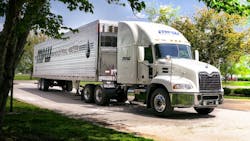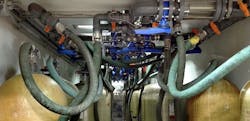About the author:
Tim Dondero is general manager for MPW’s Industrial Water Indivision. Dondero can be reached at [email protected].
A consistent flow of treated boiler-feed or process water is the lifeblood that drives system processes across a diverse range of industries. Mobile deionization (DI) or demineralization trailers are essential tools to meet those needs. Market leaders know it too, increasing the demand for mobile DI capacities.
However, utilization of mobile DI trailers with 10 million grain capacities is now becoming the new standard–or at least that is the goal for companies providing water treatment services.
High-capacity trailers enhance efficiency and can reduce a plant’s transportation by up to 50%. Likewise, they cut labor costs by about half, making 10 million grain capacity systems the go-to for projects in need of purified water in a hurry.
Protecting Productivity
While trailers of 3 million to 5 million grain capacity were once sufficient–and still can be, depending on the plant or process–having multiple 10 million grain-capacity mobile DIs on site maximizes customer outputs and minimizes downtime.
For example, a power plant in the southeast U.S. needed nearly 15 million gal of high-purity deionized water to support the startup of a series of natural gas-fired turbines. The ultrapure water needed for the steam blows had to meet stringent quality specifications, including silica levels less than 10 ppb. The water level in the power station’s feedwater storage tank could not fall below 50% at any time. If that happened, the steam blow would be terminated to allow the tank level to increase.
This mandate was in effect because other power generation units on site were producing electricity and required the high purity feedwater from the tank to remain online. Such an interruption to the steam blows would prove costly, complicated and time consuming for the engineering, procurement and construction firm and the power generation station.
MPW Industrial Services’ Industrial Water Division was awarded a contract to develop and implement a temporary system to process strained lake water to ultrapure standards. Crews set up two parallel mobile filtration units with chemical additions to process the raw, turbid, and organic filled lake water.
These systems pretreated the water before ion exchange demineralization trailers completed the purification process in compliance with the plant’s standards. Demineralization with off-site regeneration was selected for the final stage of the process because other purification methods would generate a wastewater stream, which the facility could not allow in accordance with its discharge permits. As a result, the operations team continually delivered regenerated trailers to the site to replace exhausted units, which were processed at MPW facilities.
As many as 100 demineralization trailers were dispatched to the plant during the month-long commissioning. Each trailer had a capacity of 10 million grains, which is roughly double that of a traditional trailer. This resulted in no more than 12 trailers on site at one time, reducing transportation fees and the number of hookups required. The deionized water was pumped directly to the feedwater storage tank to support the steam blow project. A mobile testing laboratory also was provided as a base headquarters for dedicated, onsite staffing to monitor all aspects of the project, including real-time data generation to verify water quantity and quality parameters. Silica and conductivity were top priorities.
The team successfully completed individual steam blows for each turbine, culminating in a common, 36-hour steam blow involving all units. During the project, a volume of ultrapure water was produced large enough to prevent the feedwater tank from falling below the 50% threshold during the job, and the steam blow was conducted without interruption. The successful execution of the steam blows led to substantial benefits for the power generation station, including reduced logistics costs, faster project completion, no reshuffling of workloads and a smaller onsite footprint.
The Future of DI
Though approximately 60% of the market still relies on 5 million grain technology, the benefits in efficiency and environmental impact of increased capacities have become more widely recognized. As a result, we will see the water treatment industry more aggressively move to 10 million grain. As large-capacity DI becomes the new standard, leading providers will continue to embrace the latest in technology and engineering to make mobile DI systems even more optimized.
For instance, reduced trailer weights using lightweight materials and reinforced fiberglass tanks that allow for more resin can increase system capacity without violating Department of Transportation standards–a hurdle for many industrial water support teams.
In addition, the vast majority of industry users install a PVC piping system, which is inexpensive in the initial investment, but degrades quickly. As high-capacity DI trailers are expected to last longer, so should plumbing systems. A high-density polypropylene (HDPE) flanged plumbing system is more resistant to cracks and leaks that could cause production delays. These piping systems are arguably more critical in a power application due to the high volume of water that must be processed in a typical production cycle.
Technological advancements also have paved the way for more customized water treatment solutions. While custom configurations are a relatively simple feature, they are vitally important when it comes to tailoring service to source water analysis. High-capacity DI trailers can be reconfigured for various resin types, lower capacities and single-vessel, dual-train or multi-vessel, allowing for greater flexibility for multiple jobs.
Once operations have begun, comprehensive and remote monitoring ensures trailers are operating at peak efficiency, and 24/7 scrutiny allows technicians to keep an eye on inlet water specs, flow rates, outlet water quality and more data points to tell customers how trailers are performing in real time.
Finally, fewer trailer swaps means reduced emissions, less water usage and less fuel consumption, providing a “greener” outlook as plants continue to come under the eco-friendly microscope.
These points can apply to units of all sizes, but a higher volume perhaps is the most important factor in mobile DI trailers. Those with 10 million grain capacities have the ability to support projects without noticeably disrupting operations, and they provide a welcome deluge of purified water in a changing industrial landscape.

